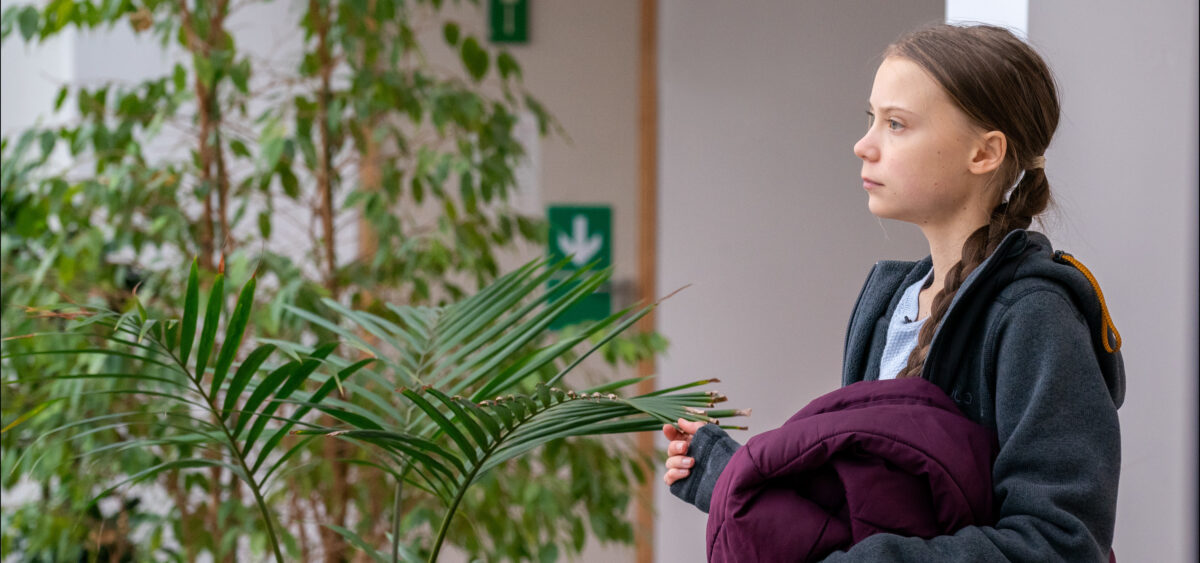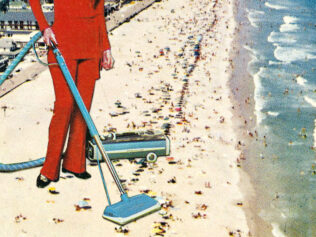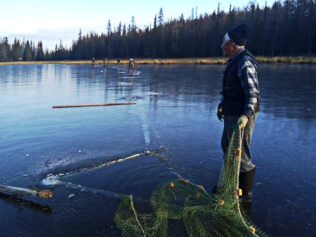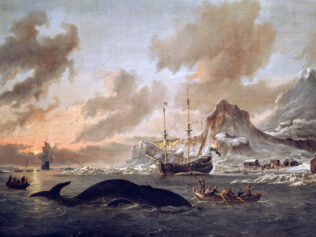
“We are facing a disaster of unspoken sufferings for enormous amounts of people. And now is not the time for speaking politely or focusing on what we can or cannot say. Now is the time to speak clearly,” says the Swedish schoolgirl, brave enough to tell the adults that they are bringing doom upon their children.
She’s small for her age. When she meets journalists from the most prominent media, they always seem surprised by this fact – how come such a tiny, unsmiling teenager is making such poignant, uncompromising statements? She calls the world leaders out on their indifference and hauls them over the coals.
Greta Thunberg, a 16-year-old Swedish girl, has become an icon of the fight with global warming. It was her sadness that kept her from growing bigger. When Greta was 11, she developed severe depression. She stopped eating, talking and going to school. One of the reasons for her breakdown was a fear for the planet. Greta was worried about the future becoming an apocalyptic nightmare, because nobody is trying to avoid this scenario. And certainly not grown-ups, who have been failing to do anything about it for the past 30 years. Greta has read about it in books, reports and research papers. She knows everything the scientists have made indisputably clear. Every one of us could realize it, too, if only climate change – an unprecedented tragedy unfolding on planet Earth here and now – was given the platform it deserves in the news, parliament sittings, corporate board meetings and school curriculums. That’s what Greta believes.
It was sheer coincidence that Svante Arrhenius (1859–1927) – a Nobel Prize laureate in Chemistry; the man who was first to investigate the greenhouse effect and propose the global warming hypothesis – was her distant relative.
Friday I’m on strike
“I don’t want your hope. I want you to panic. I want you to feel the fear I do. Every day. And want you to act.” On one August Friday in 2018, Greta rolled out a camping mat in front of the Swedish Parliament building in Stockholm. She had a banner on which she wrote: ‘School strike for climate’. Greta made a promise – first to herself, then to the global public – that she would skip school and come here every Friday until the government of Sweden commit to the Paris Agreement signed in 2015 and radically, instantly reduce the country’s CO2 emissions. That was what world leaders had agreed upon: keeping the temperature on Earth from rising more than 1.5°C compared to the pre-industrial era. Otherwise, we will be hit by a series of unimaginable catastrophes, impossible to predict in scientific models – unnatural disasters, caused by human activity and fatal in consequences. What’s even worse, they would overlap, prompt and fuel one another.
When Greta speaks – which, as she suffers from selective mutism, is a rare occurrence and brought only by necessity – she supports her claims with data from scientific studies and reports. She often refers to the alarming UN report proving we have only 11 and a half years left to cut our carbon emissions by half. By half!
Meanwhile, the world keeps following the old rules of greed and consumption, multiplied in accordance with the laws of economic growth. Scientific reports on climate change and its consequences quoted by Greta have been appearing for at least 30 years, but despite the Paris Agreement, numerous conferences and appeals to stop global warming, the engines keep pushing forward. The scientists just noted a new record: after a short moment of slowing down, humans have once again produced more greenhouse gasses than the year before. According to the yearly report “Banking on Climate Change”, since the signing of the Paris Agreement in 2015, big banks have given nearly $3 trillion to the fossil fuel industry. Greta is right: nobody is doing anything, nothing is improving.
The kings are naked, the child is honest
“You are stealing my future,” said Greta to the politicians and world leaders at the 2018 United Nations Climate Change Conference in Katowice. Most prognoses on the global future end at 2050, when Greta will be 47 years old. Taking into account the development of medicine and growing life expectancy, she won’t be even halfway through with hers. But what kind of life will it be? And what world will await her? The past five years have been the hottest in the history of modern temperature records. What comes next? Will Greta get to live long enough to see the second half of the century? Will her everyday life mean a constant fight for survival in extreme conditions? That’s what the science says, and that’s why Greta is so frightened. There are no metaphors here, no speculations. Greta is afraid of the hell that awaits her.
After her speech in Katowice, the Financial Times wrote that the climate change movement – various organizations, scattered and organized alike, all ready to fight to stop global warming – have been long waiting for their global leader. They needed an icon, a unifying voice. And it took a young girl, defending the future that awaits her, to give their postulates and appeals the authenticity and force they needed. Greta took the insular, tedious debate out of its closed rooms and dragged it onto the streets, breathing new life into it. It was Greta who told adults that they are consciously and purposefully choosing to make their children and all future generations suffer. They can no longer say they didn’t realize how serious the situation really was. Even those who never saw any of the hundreds of reports must have heard of the little girl from Sweden who tells it like it is.
Greta’s speech in Katowice didn’t fill all the seats, because she was put in the late afternoon slot. Still, the video with her presentation soon travelled far and wide across the internet. Those who listened to her in person were in awe. She also managed to impress during her spectacular TED talk and in Davos. Greta says that most adults are surprisingly understanding. Only sometimes they react with nervous smiles – as if they didn’t know what to do with themselves. She finds it amusing. And let’s keep in mind Greta – like other people born with Asperger syndrome – rarely enjoys anything. She is not entertained by irony and nuances. Greta sees the world in black and white. That’s why she can stand in front of world leaders and say without hesitation that she means business: “At places like Davos, people like to tell success stories. But their financial success has come with an unthinkable price tag. And on climate change, we have to acknowledge we have failed. All political movements in their present form have done so, and the media has failed to create broad public awareness. But Homo sapiens have not yet failed.”
In January, Greta went to Davos. She took the train – a few years ago she quit eating meat, using plastic, buying new things and flying. Her parents are doing the same. Greta’s mother gave up her career as an opera singer because she no longer wanted to travel by plane for concerts. They bought an electric car for family use. When visiting the Mecca of the wealthiest and most influential people of the planet in Switzerland, Greta stayed in a tent. It was –15°C outside, so she had to wrap up tightly in her sleeping bag, and wore a wool hat to sleep. In pictures, she seemed very comfortable with camping in the mountains. For her meeting with the world business elites, she wore bright lilac trousers and a checkered blouse. She kept her notes on her lap. Greta writes her own speeches, as she often confirms in her interviews. The girl says her dad often shakes his head in disbelief, asking her to tone it down and be less radical. His reactions only cement Greta’s conviction that it’s worth being blunt.
In Davos, she spoke calmly, in an earnest and somewhat monotone voice. She uses professional vocabulary and doesn’t shy away from specialized jargon. It’s one of the traits common in children with Asperger syndrome. They often develop deep interest – sometimes bordering obsession – in one specific topic, and talk about it in a professional way. Greta knows a lot about climate change, and is comfortable using scientific terms and data. However, the real impact of her speeches comes from elsewhere – she is uncompromising and genuine, as only children, madmen and geniuses can be.
The tribe of little warriors
In Davos, Greta reminded everyone that the need to reduce greenhouse gases emissions is vital and urgent. She held her listeners accountable. “Some people, some companies, some decision makers in particular know exactly what priceless values they have been sacrificing to continue making unimaginable amounts of money, and I think many of you here today belong to that group of people,” she said.
Canadian researcher and journalist Naomi Klein has been examining global corporate and political mechanisms for years. In 2014, she published her most recent book This Changes Everything: Capitalism vs. the Climate, in which she dissected the glaring cynicism and hypocrisy of the ostensible measures taken against global warming. Klein has often had to deal with political and business elites, and she was quick to express her support for Greta. “It takes deep courage to go to Davos and tell the masters-of-the-universe to their faces that they knowingly torched the planet in order [to] get filthy rich,” she wrote on Twitter. In response to Greta’s photo in a sleeping bag, she tweeted: “Stay warm Greta, they don’t deserve you!” The previous year, Klein had tweeted to her: “You are superhero [sic] – to me and my son. He’s lucky to have a role model like you.”
Klein decided to carry out her analytical investigation for her son’s future – in her book, she uncovered the very things Greta is talking about today. Nobody is doing anything to save our civilization and the natural order of the world. Klein claimed the only groups making a real effort to protect our planet are indigenous people – Canadian Indians, tribal communities in India, and so on. But now, one more tribe has joined them: children and teenagers.
Global school strikes
In March 2019, school climate strikes were organized in over 2000 places in around 125 countries all over the world. In total, 1.5 million young people – pupils and university students – participated in the protests. According to 350.org, it was the largest climate change demonstration in history. Greta was right when she said: “You’re never too small to make a difference.” At the protests, toddlers sat on their parents’ shoulders, holding signs with this quote. The scale of the strikes took everyone by surprise, even Greta. Responses from politicians varied. Angela Merkel and Jean-Claude Juncker were supportive of the protests, as were the mayors of many cities, from Sydney to Vancouver. But many adults keep repeating their tired old argument that children should be at school. Greta sees their criticism as an attempt to shut her mouth. “Why should I be studying for a future that soon may be no more, when no one is doing anything to save that future?” she shot back. “We are striking because we have done our homework and [politicians] have not […] If you think we should be at school, take our place on the street.”
It’s worth noting that Greta makes up for all her school absences, and despite her Friday strikes, she is still at the top of her class. She is, however, considering a gap year from school so that she can focus all her energy on climate change activism. Greta is tired. She is always in the spotlight, with a microphone almost glued to her face. “It’s like a seven-hour long press conference every Friday,” she commented.
Time hailed her one of the world’s 25 most influential teenagers, and she was chosen the ‘Woman of the Year’ in Sweden. In just a few months, Greta Thunberg became a leader of a global movement, with a chance of pushing climate change to the first pages of the world’s mainstream media. She might get a Nobel Prize, too.
No planet B
Greta was nominated for the Nobel Peace Prize by Norwegian and Swedish politicians. She is among 301 other proposed candidates, the laureate to be announced in December this year. Among the nominees, there are 223 individuals and 78 organizations. Still, Greta stands a serious chance. Her actions have empowered very young people on every continent, including Africa and Asia, where climate change has been causing suffering and severe consequences for years. Inspired by the protest of a single girl, connected by social media, internet-savvy young people mobilized instantly to show adults that they are angry, demanding and ready to get politically involved.
The majority of protesters were people who – just like Greta – are too young to vote. Now, however, they have gone through their political and social rite of passage, and many of those children are very serious about the future. They have just one demand: fast and unsparing reduction of greenhouse gases emissions, in accordance with the scientific guidelines. They know that whatever quirky space-conquering dreams Elon Musk or Richard Branson might be harbouring, there is no planet B we could all escape to.
A big issue for small people
Greta started striking because she was feeling helpless. Her parents say that once their daughter decided to go on strike, she found new strength. To Greta, protesting was a form of therapy. Earlier on, her teachers told her about global warming and the tonnes of plastic waste polluting the oceans. She started reading about it. Later, she won a press competition for the best article on global warming. It gave her new energy, and enabled her to get in touch with climate activists. However, those meetings turned out to be a disappointment. They planned strikes in classrooms and on schoolyards, but when it was time to act, nobody wanted to join Greta. So she took her foam mat and sat in front of the parliament herself. She was tired of the slow-killing apathy.
Perhaps it is this act of genuine awakening, finding the strength to act and the feeling of agency – maybe those are the things that provide the spark needed to turn helplessness into fury and the courage needed to oppose the establishment before one becomes part of it and gets tangled in the consumerist lifestyle, with its philosophy of eternal debts and mortgages. If we assume that every generation needs its own revolution to shape their identity, place and purpose in the world, it looks like the iGeneration kids have just found their cornerstone. The stakes are high: their lives and future, whose quality and circumstances are still being shaped by myopic adults today.
Research on American teenagers shows that they are not interested in politics, but are highly skilled in organizing around an issue they find important. Today’s youth are less active than the previous generations – they take longer to become independent, live with their parents and go on holidays with them, and are financially dependent on them for longer. They spend lots of time on their phones, and usually cannot even say what exactly they were using it for. This is not to say the reports are unequivocally negative – they just show that a significant change has occurred. For today’s kids, adulthood no longer seems like something cool and desired. On the other hand, it’s the very thing they want to avoid for as long as possible.
But what to do when adults fail and act like irresponsible children themselves?
Who’s the grown-up here?
Greta’s strike was inspired by the movement of American teenagers demanding gun law reforms in the US. Those children marched and gathered in defence of their own lives – literally, as children and teenagers are the victims of mass shootings in schools and at university campuses. Greta’s actions are a symptom of the social role psychologists call parentification: today’s adults are behaving like selfish, thoughtless brats, and children take the burden of responsibility for their dangerous games. In her speeches, the young Swedish leader uses a typical rally-like narrative, saying that adults will be held responsible for their neglect, even though this promise might be hard to execute. The youth, worried about climate change, have access to only one kind of capital: the ability to communicate, connect and exchange knowledge and information quickly. But Greta must realize that they don’t have the tools or the power necessary to bring real change.
Greta’s brilliant, moving speeches tempt us to believe that she and her generation will ‘solve global warming’. This fantasy shows just another aspect of parentification – burdening the child with the role of caretaker for the adult, as if little Greta and her peers were supposed to save the adults, rotten with inertia and cowardice. Her actions also give us this false sense of comfort: there is still time to act. But our time is up. The disaster is already here. The scientists have proven it, and Naomi Klein shouted about it in her latest book: “There are other times ‘when you need to run like a buffalo.’ Now is one of those times when we must run.”
Nobody knows what to do
For the first 15 years of her life, Greta was the quiet girl in the back – she felt invisible and unheard. And then, within just six months, she became someone greeted with applause, quoted, taken seriously by the leaders of the European Union, United Nations, Amnesty International. She is the person with whom every man in power wants to take a selfie. This fast-accumulated capital comes with a threat, both for Greta and for the goal she is trying to achieve.
One of the dangers ahead of her is the risk of excessive expectations. “People keep asking me ‘what is the solution to the climate crisis.’. And how do we ‘fix this problem’. They expect me to know the answer. That is beyond absurd as there are no ‘solutions’ within our current systems. No one ‘knows’ exactly what to do,” wrote Greta on Facebook. But we know what isn’t working. “We can no longer only focus on individual and separate issues like electrical cars, nuclear power, meat, aviation, bio fuels etc etc. We urgently need a holistic view to address the full sustainability crisis and the ongoing ecological disaster,” she continued.
Her poignant words are met with applause by those in power. They honour the girl and pacify her at once. Greta’s incisive comments are beyond dispute, but the implementation of her demands is difficult. Awe and admiration for Greta’s bold honesty allow us to push away another truth: all key policymakers know the facts and realize the scale of action that must be undertaken to achieve real change rather than a PR touch-up. And these real obstacles are holding back even those who have the knowledge and the will to act. To reduce greenhouse gases emissions by 50% in just over a decade? Of course. But how? And who is going to pay for it? Pointing out the need for change is one thing. But finding the way to do it is a whole other issue. And that’s the point of all those unsuccessful conferences and climate panels, resulting with little to no progress. That’s why we keep signing those painfully drafted compromise agreements. Greta is right to demand more from the global elites. Still, she lacks the life experience to know that not many things in life are really black and white, and good intentions are rarely enough to make a change. It also takes a lot of cooperation and consistency.
This is the troublesome part, and grown-ups would very much like to take a break from it. Which is why they find it so easy to applaud protesting teenagers, to congratulate hem and say that it’s now time for children to take care of the world. But this would be the worst thing that could ever happen. This way, the youngest generation would be robbed not only of their future, but also of their childhood. If the progress of civilization is to be measured by the well-being of the new generations, protesting children are the living proof of our crushing failure and regress.
When the applause dies down
What is going to happen to Greta Thunberg next? What future awaits our planet and the iGeneration? Perhaps she will be silenced with praise, and the world will keep rolling straight into climate disaster. The quick rise of the Swedish activist means the efforts to downplay her success will get to work just as quickly. It’s already happening – the media are implying that Greta’s actions are just a PR stunt to promote her mother’s book. One Belgian minister suggested the school strike for climate on 15th March was organized by radical ecologists who send children to the front lines. He quickly took his words back and resigned, but an army of critics keep chanting their mantra that global warming is a myth, and Greta Thunberg is just a puppet in the hands of radical environmentalists.
The Nobel Peace Prize may lead Greta to become a professional activist, just like the women’s rights advocate Malala Yousafzai, who received the accolade in 2014 as the youngest laureate in history, being 17 at the time. Paradoxically, receiving the Nobel Prize might do Greta Thunberg more harm than good, entangling her into a pointless, decades-long debate on climate change. And the uselessness of such empty disputes is the very thing she is pointing out today.
The real goal of Greta’s protest is to force all of us, especially those in power, to change our way of thinking. Her alarmist, harsh message carries a very serious expectation: we must build a new, better world. And we must do it now.
Translated by Aga Zano









